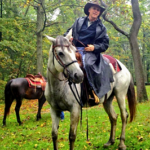On the barrier islands of Maryland, Virginia, North Carolina and Georgia, summers are scorching hot, and the scrub brush offers little shade. Storms lash the islands with wind and waves, often flooding the high ground. The salt marsh mosquitoes and flies are brutal, capable of draining 500 cubic centimeters of blood from a horse in one day.
In this inhospitable environment, hardy little horses survive and flourish, as they have for centuries. Did they swim ashore from shipwrecks? Were they abandoned by New World homesteaders? Or does their presence here predate Columbus? Have they actually been here for 55 million years, remnants of prehistoric equine species?
It comes as no surprise that wild horses are a fabric with hundreds of threads. In their veins is the blood of Spanish stock – jennets and barbs imported by conquistadors – and the blood of breeds developed by the colonials.
But more important than their past, what will be their future? Bonnie Urquhart gives us an impassioned account of six years of research on the wild herds, time spent sitting in blinds photographing, sketching, slapping mosquitoes, and studying behavior which is unique in every herd.
Her theme throughout the book, which is illustrated with her own photos, is that man holds the destiny of these feral creatures. The debate over their fate is fiery. Some say the horses are not truly wild, having descended from domestic animals, and do not deserve the same protection as other wildlife on the islands.
Though they are a part of the rich barrier island history and are beautiful to watch, wild horses are also perceived as a destructive element. Overbreeding, which stresses an island’s equine population, leads to the stripping of fragile island vegetation and the destruction of habitats for other animals and birds.
It’s a disturbing dilemma, for what horse lover doesn’t thrill at seeing wild horses grazing among the dunes, just like Misty of Chincoteague?
“Only through understanding can we hope to make rational, educated decisions about the welfare of these animals,” says Urquhart. “[They] have value simply because they are wild horses, and because they touch the wildness in our own souls.”
Hoofprints in the Sand, published by Eclipse Press (April 2002), retails for $24.95. It is 168 pages long, with 50 color and 3 black and white illustrations. Buy it from your local bookseller or order from www.exclusivelyequine.com or call (800-582-5604).







